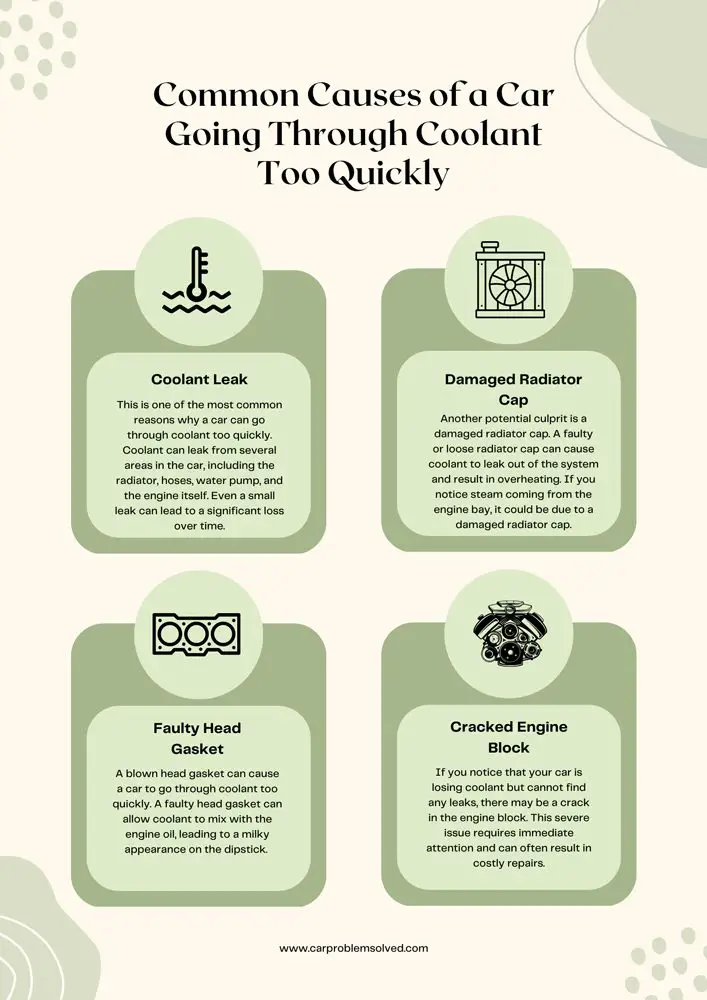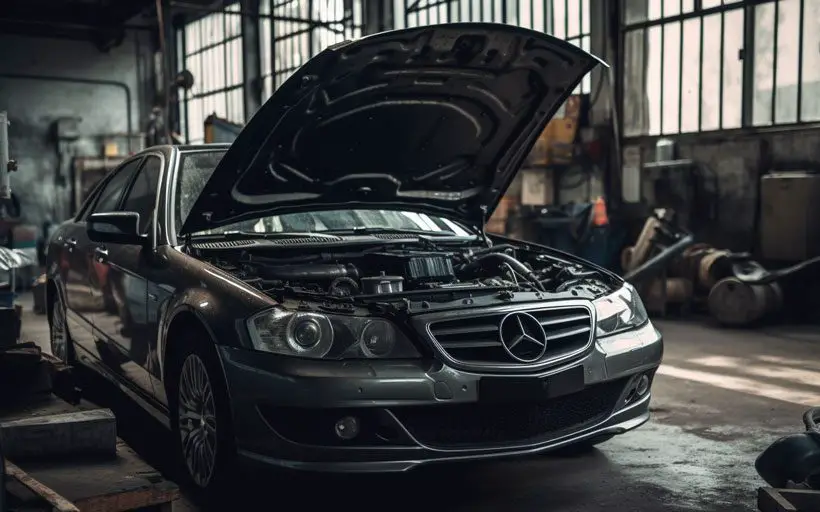A car going through coolant fast is a problem that can lead to engine damage and costly repairs if left unaddressed. Coolant, also known as radiator fluid, plays a crucial role in keeping the engine cool and preventing it from overheating.
If you experience your car going through coolant fast, this can be caused for different reasons. The reasons are listed below.
- Leaks in the cooling system
- A faulty radiator cap
- A blown head gasket
- A cracked engine block
It’s essential to identify the root cause of the problem and take steps to fix it promptly to avoid further damage to your car’s engine. In this article, we will explore the causes and solutions for a car going through coolant too quickly.
The Importance of the Proper Balance of Coolant in the Cooling System

Maintaining the proper balance of coolant in your car’s cooling system is crucial to ensure its proper functioning.
- Coolant plays a vital role in regulating the engine’s temperature and preventing overheating.
- When its level drops too low, it can cause the engine to overheat, which can lead to costly damage and even engine failure.
- Coolant also helps protect the engine from corrosion and rust, which can cause leaks in the cooling system, leading to its loss.
A loss of coolant can also occur due to a faulty radiator, water pump, or a leaking hose. If you notice that your car is going through coolant faster than usual, it is essential to have it inspected by a qualified mechanic.
In addition, it is important to remember that using the correct type of coolant is equally important. Using the wrong type can lead to a chemical reaction, causing damage to the engine and cooling system.
Overall, maintaining the proper balance of coolant in your car’s cooling system is crucial to ensure its longevity and prevent any costly damage.
Common Causes of a Car Going Through Coolant Too Quickly

If you find that your car is using up coolant faster than usual, there may be several reasons. Some of the most common causes include:
Coolant Leak
This is one of the most common reasons why a car can go through coolant too quickly. Coolant can leak from several areas in the car, including the radiator, hoses, water pump, and the engine itself.
Even a small leak can lead to a significant loss over time. Hence, it’s essential to identify and repair any leaks as soon as possible.

Damaged Radiator Cap
Another potential culprit is a damaged radiator cap. A faulty or loose radiator cap can cause coolant to leak out of the system and result in overheating. If you notice steam coming from the engine bay, it could be due to a damaged radiator cap.
Faulty Head Gasket
A blown head gasket can cause a car to go through coolant too quickly. A faulty head gasket can allow coolant to mix with the engine oil, leading to a milky appearance on the dipstick. This results in
- Overheating
- White smoke from the exhaust
- A sweet smell in the cabin
It’s essential to get a blown head gasket fixed as soon as possible, as it can cause severe engine damage.
Cracked Engine Block
If you notice that your car is losing coolant but cannot find any leaks, there may be a crack in the engine block. This severe issue requires immediate attention and can often result in costly repairs.
Diagnosing Fast Coolant Loss

If you are losing coolant fast, then it’s necessary diagnosing the cause. Here are the steps to take.
Step 1: Monitoring Coolant Levels
This is one of the first things you should do. The reservoir tank of coolant is usually transparent and marked with the minimum and maximum levels. Keep an eye on the level in the tank for a few days to see if it drops rapidly.
Step 2: Checking for Visible Leaks
The next step is to check for any visible leaks in your car’s cooling system. Look for puddles of coolant under the car or signs of leakage around the radiator, hoses, or water pump. You can also inspect the hose clamps for any signs of damage or looseness.

Step 3: Inspecting the Radiator Cap
A radiator cap with a worn-out gasket can allow coolant to escape from the system. So, check the radiator cap for any visible signs of damage, wear, or corrosion.
Step 4: Performing a Compression Test
Compression tests can help you identify a blown head gasket or cracked engine block. Here’s the process for the test:
- Remove the spark plugs and connect a compression gauge to the cylinder.
- Crank the engine and note the reading on the gauge.
- Repeat the process for each cylinder and compare the readings.
- If there is a significant difference in the readings between cylinders, it may indicate a problem with the head gasket or engine block.
Note: This is a complex task as it requires dealing with the internal engine components. Hence, it’s recommended to take professional help.
Solutions for Addressing a Car Going Through Coolant Too Quickly
After identifying the root cause of your car’s excessive coolant consumption, you can take steps to address the issue. Here are some common solutions for different scenarios:

Repairing the Coolant Leak
Take the following measures to repair leaks.
- Step 1: Locate the source of the leak by inspecting the hoses, connections, and other components that carry coolant around the engine.
- Step 2: Look for signs of cracks, corrosion, or loose fittings that may cause coolant to escape.
- Step 3: Once you have identified the leak, you can repair or replace the damaged part or use a sealant product to plug the hole temporarily.
Replacing the Radiator Cap
If the radiator cap is not sealing properly, it can allow air to enter the cooling system and create pressure fluctuations that lead to coolant loss. In this case, replacing the cap with a new one can solve the problem.
Make sure to choose the right size and pressure rating for your car’s cooling system. Then follow the following process:
- Step 1: Wait until the engine is cool, and then remove the old cap by turning it counterclockwise.
- Step 2: Clean the neck of the radiator and the sealing surface of the new cap with a rag, and then place the new cap in position.
- Step 3: Twist it clockwise until it clicks and locks in place.
- Step 4: Be careful not to over-tighten the cap, as this can cause damage to the threads or the seal.
Fixing the Faulty Head Gasket
If you suspect a head gasket failure, you should have it checked by a professional mechanic. He can perform a compression test, a coolant pressure test, or a chemical block test to confirm the diagnosis.

Depending on the severity of the damage, the head gasket may need to be replaced, or the engine may need to be rebuilt or replaced.
However, if you wanna DIY the process nevertheless, then here is the process:
- Step 1: Disassemble the engine.
- Step 2: Remove the old head gasket.
- Step 3: Clean the mating surfaces.
- Step 4: Install a new gasket.
You may also need to inspect the cylinder head and the engine block for cracks, warping, or other damage and perform any necessary repairs. Finally, reassemble the engine and test it for leaks and proper operation.
Addressing the Cracked Engine Block
If the engine block is cracked, coolant can leak into the oil pan, the exhaust system, or the combustion chamber, causing severe damage to the engine.
In this case, repairing the crack may not be feasible, and replacing the engine or the car may be the only option.
The replacement process can be complex and expensive, and it typically involves-
- Removing the old engine
- Installing a new or rebuilt engine
- Reconnecting all the components
This process may also require additional repairs or modifications, such as-
- Replacing the transmission
- Upgrading the exhaust system
- Adjusting the engine mounts
It is essential to work with a reputable mechanic or a dealership to ensure that the replacement is done correctly. It’s also important to make sure that the new engine is compatible with your car’s make and model.
Preventive Maintenance Tips for Avoiding Coolant-Related Problems

Here are some tips to prevent coolant-centric problems from occurring.
Regular Maintenance
Regular maintenance is crucial to keep your car running smoothly and prevent coolant-related problems. It is recommended to follow the manufacturer’s guidelines for scheduled maintenance. This may include-
- Checking the coolant level
- Flushing the system
- Replacing the coolant
Coolant System Checks
Regularly inspecting the coolant system is essential to ensure that it is functioning correctly. Some of the things you can check include the following:
- Coolant level: Check the coolant level regularly, especially before long trips.
- Coolant color: The coolant should be a bright, clear color. If it is dark or discolored, it may be time to replace it.
- Coolant leaks: Check for coolant leaks under the car, around the hoses and clamps, and the radiator.
- Radiator cap: The radiator cap should be tight and in good condition.
Monitoring Temperature Gauge
Monitoring the temperature gauge is essential to detect overheating before it becomes a significant problem. The temperature gauge should stay in the normal range during normal driving conditions.
If it starts to move towards the hot side, it may be a sign of a coolant-related problem. Stop the car and check the coolant level for any leaks. If everything appears normal, the problem may be more severe, and a mechanic should be consulted.
If you’re experiencing a rapid loss of coolant in your car, it’s important to determine the underlying cause to prevent potential engine damage. While coolant loss can be attributed to various factors, such as leaks or system malfunctions, understanding why your coolant is not circulating properly is crucial. Our article on why is my coolant not circulating provides insights into common causes and solutions for this issue, helping you identify and address the root problem. Additionally, if you’re puzzled by the continuous disappearance of engine coolant, our article on why does my engine coolant keep disappearing delves into potential reasons for this phenomenon, guiding you through the troubleshooting process. By exploring these related topics, you can diagnose and resolve coolant-related concerns, ensuring optimal engine performance and longevity.Conclusion
If your car is going through coolant too quickly, it is crucial to address the issue promptly to avoid engine damage and costly repairs. By identifying the root cause of the problem, you can take the appropriate steps to fix it.
It doesn’t matter if it’s repairing a leak, replacing the radiator cap, or fixing a faulty head gasket. It’s essential to work with a qualified mechanic who can diagnose the issue accurately and provide you with a reliable solution.
Regular maintenance, such as coolant flushes and inspections, can also help prevent coolant-related problems. Take care of your car’s cooling system balance to keep it safe, reliable, and efficient for years to come.
